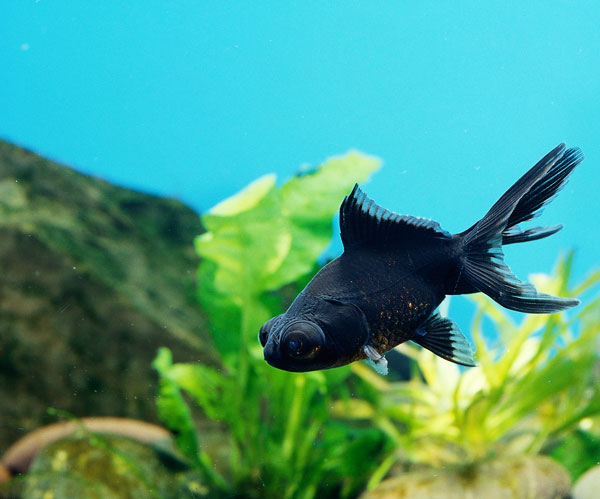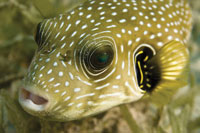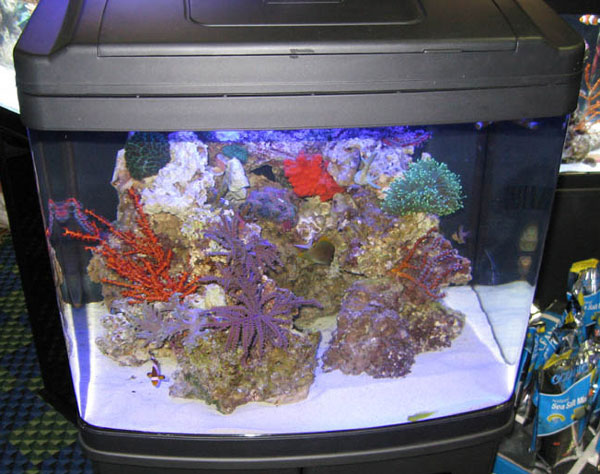

The moor goldfish contracted a fungus. They have fuzzy white hair-like spots on their tails, with a red tinge around each one. They lay on the gravel, only coming up to eat fish food.
Next my ryukins had problems. One has a white ring around the eye. The other has bright red spots, and the scales are protruding from its body.
Now all the fish have red around some of the scales. It almost looks as it they are bleeding. I have been treating it with Aquari-Sol.
I don't know what I have done wrong. I always do regular water changes every other week. Any information on these problems and how to get rid of them would be greatly appreciated.
A. Dealing with fish diseases is probably the most frustrating experience in fishkeeping. Diagnosis is typically difficult, with many fish diseases having similar signs and symptoms. Even when a diagnosis is correct, finding a timely and effective treatment is a hit-and-miss proposition.
Among the most common and most easily diagnosed fish "diseases" is saprolegniosis. This is a fungal invader that reveals itself with a profusion of white, gray, green or brown cottony tufts protruding from the fish's skin. It can appear anywhere on the fish.
Saprolegniosis in ornamental fish is primarily caused by one of three genera of aquatic fungi: Saprolegnia spp., Achlya spp. or Dictyuchus spp. All their basic characteristics are virtually identical (even fungi specialists have trouble sorting them out), so it's best to think of them as a single fungal invader.
These fungi are found in all freshwaters worldwide and are always present in some form. Healthy fish easily control this fungus disease. The outer slime coat that covers a fish's skin acts as a shield against fungal invasion.
However, when fish are physiologically stressed or when they are battling some bacterial or parasitic disease they become susceptible to fungal invasion. In this respect, Saprolegniosis is not a primary disease, but becomes a disease problem after some other serious health problem exists.
Once saprolegniosis takes hold it can pose a much greater risk to the host fish than the initial disease. The fungi spread vegetatively below the host's skin tissues, and underlying muscles, flesh and bone are exposed as the dead skin drops away.
Your task is twofold. First you need to stop the saprolegniosis invasion and stabilize the condition of the fish. Remove all affected fish to a properly filtered hospital aquarium to protect the remaining healthy ones. Diseased fish stress healthy ones and act as breeding grounds for additional pathogens, increasing the number of fungi spores in an aquarium by thousands of times. If all the fish in your aquarium are diseased, treat them in the display aquarium.
The most effective treatment for this fungus disease is malachite green. For this treatment use a separate freshwater aquarium with a simple airstone aerator, although a 4-gallon bucket will usually suffice. The water should match the pH and temperature of the display aquarium. Move the infected fish by scooping them up in a jar of water. Do not use a net. Each of the fish should be given a one-hour bath in a 5-parts-per-million (milligrams per liter) concentration of malachite green every day for a week. The main and hospital aquariums should be kept clean, with special attention paid to removing organic matter in the gravel using a gravel vacuum.
Saprolegniosis first invades weakened tissues, but quickly spreads to adjacent healthy areas and deep into the underlying muscle. You have observed the bloody areas, with tissues falling away. These openings create an osmotic imbalance in the fish — vital minerals seep away into the water. This results in osmotic shock, killing the fish. Meanwhile, the metabolism of the fish attempts to compensate, using large amounts of energy that could go into healing. You can help reduce the risk of shock and the diversion of energy by adding ordinary salt to the water. Keep the fish in a 0.1- to 0.2-percent salt solution until the wounds are completely healed (roughly 1 tablespoon of salt per 4 gallons of water).
Once things are stabilized, your next step is to figure out what weakened the fish and made them susceptible to saprolegniosis. Start with water quality. Check water pH, temperature and even oxygen levels. Is there residual chlorine in the water? What are ammonia and nitrite (not nitrate) levels?
Next, consider physical injury. Are there sharp or abrasive items in the freshwater aquarium? Have you recently netted the fish? Are there overly aggressive fish in the aquarium that chase and nip? This is almost always a problem when goldfish are kept with other freshwater fish species, especially pleco catfishes.
Are there signs of primary pathogens? Large parasites, such as anchor worm, fish lice and leeches, create large openings in fish skin. Smaller parasites, such as ich, do just as much damage. These pathogens alone rarely cause fish death, but you will have to deal with them after the fish fungus problem is stabilized.
There are other possibilities. Are the fish underfed (almost unheard of in the aquarium hobby)? Perhaps the freshwater aquarium is overcrowded (almost a certainty in the aquarium hobby). Did you add new animals to the aquarium?
Most fish disease problems are induced by the fishkeeper. Fungal infections are a good indicator of some other problem lurking in the background — a problem you can control.
 Would You Like The Supreme Fishing Experience? Heres The Reason Why It Is Essential To Carry The Mo
If what youre seeking out is considerably more fish thr
Would You Like The Supreme Fishing Experience? Heres The Reason Why It Is Essential To Carry The Mo
If what youre seeking out is considerably more fish thr
 Reefdoser Pro for iPad Ships
Reefdoser Pro for iPad Ships
 Pufferfish Teeth Care
Because their teeth are constantly growing, pufferfish
Pufferfish Teeth Care
Because their teeth are constantly growing, pufferfish
 Useful Idea For Stronger Nutrition And Wellness
It truly does show when you take time to create a proper no
Useful Idea For Stronger Nutrition And Wellness
It truly does show when you take time to create a proper no
 Marine Nano Tank Problems
Marine Nano Tank Problems
Copyright © 2005-2016 Pet Information All Rights Reserved
Contact us: www162date@outlook.com